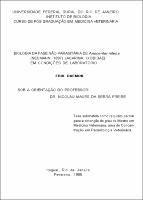Please use this identifier to cite or link to this item:
https://rima.ufrrj.br/jspui/handle/20.500.14407/11705| Tipo do documento: | Dissertação |
| Title: | Biologia da fase não parasitária de Anocentor nitens (Neumman, 1897) (Acarina: Ixodidae) em condições de laboratório |
| Authors: | Daemon, Erik |
| Orientador(a): | Freire, Nicolau Maués da Serra |
| Primeiro membro da banca: | Freire, Nicolau Maués da Serra |
| Segundo membro da banca: | Mello, Rubens Pinto de |
| Terceiro membro da banca: | Evans, David Eric |
| Keywords: | Medicina Veterinária |
| Área(s) do CNPq: | Medicina Veterinária |
| Idioma: | por |
| Issue Date: | 5-Feb-1985 |
| Publisher: | Universidade Federal Rural do Rio de Janeiro |
| Sigla da instituição: | UFRRJ |
| Departamento: | Instituto de Ciências Biológicas e da Saúde |
| Programa: | Programa de Pós-Graduação em Ciências Veterinárias |
| Citation: | DAEMON, Erik. Biologia da fase não parasitária de Anocentor nitens (Neumman, 1897) (Acarina: Ixodidae) em condições de laboratório. 1985. 110 f. Dissertação (Mestrado em Ciências Veterinárias) - Instituto de Ciências Biológicas e da Saúde, Universidade Federal Rural do Rio de Janeiro, Seropédica - RJ, 1985. |
| Abstract: | Com o objetivo de caracterizar a biologia da fase não-parasitária de Anocentor nitens (Neumann, 1897), e comparar os resultados obtidos para cepas de origem eqüina e bovina, foram utilizadas 56 teleóginas provenientes de infesta- ções naturais de equídeos (cepa eqüina) e 98 teleóginas provenientes de bovinos, tendo sido 50 obtidas de infestações artificiais com larvas de origem eqüina (cepa bovina P) e 48 de infestações com larvas de origem bovina (cepa bovina F1). Todas as fases evolutivas, após a obtenção das teleóginas, foram mantidas a 27°C e umidade relativa superior a 80%. Não houve diferenças sensíveis entre os períodos de pré-postura e de eclosão dos ovos nas três cepas estudadas; os períodos de postura e de sobrevivência das fêmeas foram superiores para as cepas bovinas. A eclodibilidade dos ovos foi ligeiramente mais baixa para a cepa bovina F1 (86,64%) do que a das cepas eqüina e bovina P (92,54 e 90,66%, respectivamente); os ovos provenientes do final do xvii período de postura foram inférteis. O peso médio de um ovo foi significativamente menor (P < 0,01) na cepa eqüina, quando comparada às cepas bovinas, e os valores obtidos nessas últimas não variaram significativamente entre si. A cepa eqüina apresentou a maior produção de ovos por grama de teleógina, seguida das cepas bovina F1 e bovina P. Constatou-se que a cepa bovina F1 teve melhor desemI penho biológico, na fase não-parasitária, que a cepa bovina P, com possibilidade dessa tendência vir a tornar A. nitens tão adaptado a bovinos quanto a equídeos. |
| Abstract: | The present study had the main intention of establishing the characteristics of the biology of the non-parasitic stage of Anocentor nitens (Neumann, 1897) and comparing the results obtained from strains of equine and bovine origen. For this purpose, 56 engorged tick females taken from natural infestations in equids (equine strain) and 98 engorged tick females taken from bovines, were utilized; 50 from these latter were obtained from bovine artificial infestations, With larvae for equine origin (Bovine strain P) and 48 from infestations with larvae from bovine origin (Bovine strain F1) After obtaining the engorged tick females, all the developmental stages were kept at 27°C and humidity above 80%. There were no strong differences between the preegg laying and hatching periods in the three strains studied; the periods of egg laying and survival of females were higher for the bovine strains. The egg hatchability were slightly lower for the bovine strain F1 (86,64%), than those of the x i x equine and bovine P strain (92,54 and 90,66%, respectively); the eggs taken from the last days of the egg laying period proved to be infertiles. The mean weight of one egg was significantly lower (P<0,01) in the equine strain, when compared to bovine strains and the results obtained in these latter didn't vary significantly between then. The equine strain showed the greater production of eggs per gram of engorged female tick followed by the bovine strains F1 and P. At the end of the present study we found that the bovine strains F1 had a better biological performance, in the non parasitic stage, than the bovine strain P, with the possibility that this tendency makes A. nitens as well adapted to bovines as to equids. |
| URI: | https://rima.ufrrj.br/jspui/handle/20.500.14407/11705 |
| Appears in Collections: | Mestrado em Ciências Veterinárias |
Se for cadastrado no RIMA, poderá receber informações por email.
Se ainda não tem uma conta, cadastre-se aqui!
Files in This Item:
| File | Description | Size | Format | |
|---|---|---|---|---|
| 1985 - Erik Daemon.pdf | Erik Daemon | 593.62 kB | Adobe PDF |  View/Open |
Items in DSpace are protected by copyright, with all rights reserved, unless otherwise indicated.

